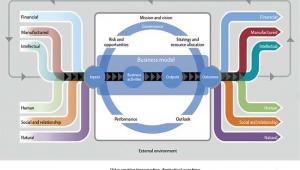Speakers at the first meeting of the International Integrated Reporting Council’s Public Sector Pioneer Network in London on May 27 discussed the development of <IR> for the public sector.
Opening the event, IIRC chair Professor Mervyn King said that since the launch of the pioneer network with the World Bank and CIPFA last November, 34 organisations from across the globe had already participated in webinars about the principles of integrated reporting.
<IR> is based on integrating an organisation’s thinking about its work and how it creates value, he said. An integrated report therefore looks at an organisation’s use and contribution to six “capitals” – financial, manufactured, intellectual, human, social and relationship, and natural – to promote an understanding of their interdependencies and value creation over time.
These principles can apply to the public sector organisations as many were already run as integrated institutions, King highlighted.
“Just take a hospital – the running of a hospital on a daily basis is on an integrated, inter-connected, inter-related manner,” he told delegates.
“We talk of the six capitals used by an entity, and we also talk about the ongoing relationships with an entity’s stakeholders – identifying them and learning of their legitimate and reasonable needs interests and expectations. None of this happens in silos, and in running a hospital on a daily basis management deals with it on an integrated basis.”
In this context, a traditional form of financial reporting was “critical but on its own clearly not sufficient” amid increasing awareness of the impact non-financial aspects of an organisation can have, King said.
Other speakers also highlighted how <IR> could help contribute ensure the long-term viability of public services.
Zinga Venner of the World Bank, who is leading on the organisation’s move to <IR> as part of the PSPN, said the public sector had a role in value creation across society, but needed a different kind of reporting from the private sector.
“Shareholders are able to choose what companies they can invest in, but the public sector has taxes. It is almost like a contact for society, so there is a need to have accountability.
“More importantly, with respect to scarcity of resources, there are trade-offs with how resources can be used, and the key is how to make sure resources are used as efficiently and effectively as possible. What is the metric that is going to be used for resource allocation between different areas within society?”
This was where <IR> can play a role in political decisions related to resource allocations, she indicated.
“There is often a risk that when you have a change in government, then certain programmes get discontinued. So how do you ensure there is continuity? If there is more transparency in terms of the value that is being created by this particular programme, there is a high likelihood of continuation.”
In an example of how <IR> could be used to help allocate public resources, Ben Wielgus of KPMG set out how the principles have been used in the UK city of Bristol as part of its year as European Green Capital in 2015.
As part of the Green Capital plans, <IR> has been proposed to measure progress on indicators based on the six capitals. This was now being considered for adoption by Bristol City Council to ensure the solution is fit for all stakeholders.
The <IR> framework could help prioritise resources by looking at the benefits and costs of a public park, for example, across indicators linked to the capitals, Wielgus highlighted.
“In an age of austerity, where there are mandatory cuts of 40% on every council budget [in the UK], it helps us ask the question of whether we should really be cutting these things evenly, or do certain things in a council create more value, more capital, in certain areas than others.
“You might then say, ‘shouldn’t we be spending more in parks, because – in an age when we can’t afford libraries, community centres and public gyms – maybe parks become the place where people want to go and exercise’.”
Expanding on this example, Wielgus said this integrated thinking could then lead to collaborations across the public sector.
“Maybe now, in an age when we’re devolving the NHS budgets in Manchester and other cities [in England], if we can value the amount of money that parks save our health service, we can get the health service to pay for it.”
Ian Carruthers, CIPFA’s executive director of policy and standards, agreed <IR> could help describe how the public sector worked, and what can be achieved through a broad range of interactions. This was an area the pioneer network was keen to explore, he said, as it worked on honing how the <IR> concept of value creation could apply alongside CIPFA’s Good Governance in the Public Sector framework.
“The research that CIPFA did during the initial development of the integrated reporting framework came to the conclusion in discussions with shareholders that the ideas behind integrated reporting should really be easily applicable to the public sector,” he concluded. “We should be able to take the ideas further.”
• More details on the Public Sector Transformation Network can be found here.












